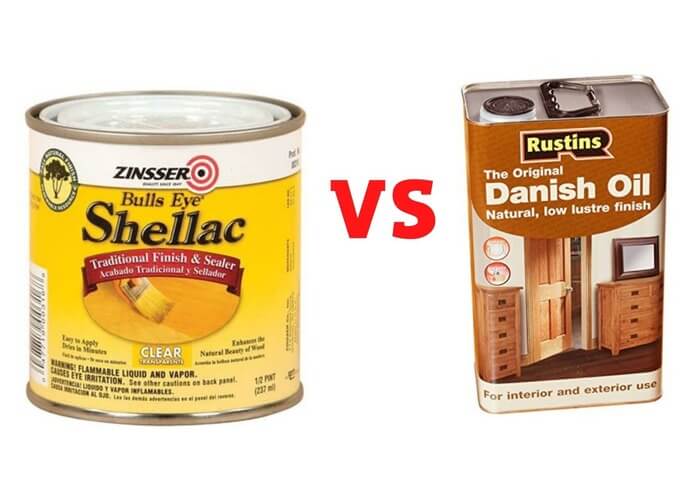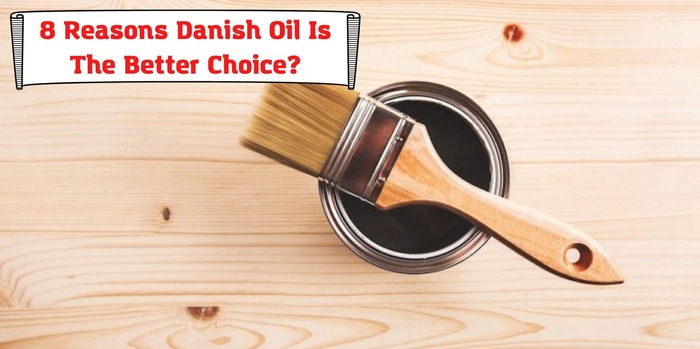
Choosing the right finish for your woodwork project is important for wood protection and aesthetic purposes. That’s probably why you’re wondering which finish is better for your woodworking project between Shellac and Danish oil. Well, you’re not alone. Many woodworkers, especially beginners get confused about these two finishing products as they have very similar characteristics.
Before you decide, you need to know them better. In that case, we’ve got you covered. We will tell you which finish is better and why based on the opinion of many experts. So, without further ado, let’s get started.
Which Is Better: Shellac Or Danish Oil?
Any woodworker (beginner or not) can become confused when choosing between Shellac and Danish oil for wood finishing. It’s hard to say for sure which one is better – they both have their pros and cons for certain conditions. Both Shellac and Danish oil are incredible wood finishing products.
They provide an excellent finish on many types of woods. These products also cure fast, making them a popular choice among many professionals. But, sometimes, you have to choose one for a more elaborate and accurate wood finishing. That’s where Danish oil plays better, and we will tell you why.
There are two things you should know before we give you the reasons for choosing Danish oil over Shellac:
- Categories of Wood Finishing Products – There are so many types of wood finishing products. However, they are all categorized into two groups: penetrating and surface. Surface finishes stay at the surface of the wood while penetrating ones penetrate the surface. Surface finishes are better when you want to obtain a thicker appearance. On the other hand, penetrating finishes provide a thin layer of protection and are chosen for interior items mostly.
- Danish Oil Varieties – Danish oil is a mixture of tung oil, linseed oil, and mineral spirits. This wood finishing oil is available in different varieties from different manufacturers. That’s because there’s no standard, pre-defined mixing ratio for the ingredients. You should be familiar with the various Danish oil types to know the right one for your project.
8 Reasons Danish Oil Is The Better Choice?

Reason #1: Danish Oil Waterproofs Wood Better
Danish oil is a penetrating wood finishing product unlike Shellac, which is a surface finish. The penetrating property enables the oil to give wood a strong finish after drying. By penetrating the grains of the wood, it dries into a hard seal that water molecules can’t go through. That’s how it waterproofs wood and protects it against any water damage.
Shellac is also water repellent and will also waterproof your wood. However, being a surface finish, it dries into a thin glossy sheen that’s prone to chipping off with time. That’s especially true for furniture subjected to heavy use. When that happens, the furniture will be exposed to water damage unless another coat is applied soon.
Danish oil is more resilient, and its protective finish will protect the wood for a longer time. Its finish is thicker and not predisposed to chipping off with time. Therefore, Danish oil has a more reliable wood waterproofing ability than Shellac.
Reason #2: Danish Oil Is Alcohol-Resistant
Shellac dissolves in alcohol. So, avoid using alcohol to wipe furniture that has a Shellac finish. Conversely, Danish oil is naturally resistant to alcohol and liquids. That also explains why it would offer better protection than Shellac.
The protective finish that Danish oil creates is only weak during the first week after application. Ensure you wipe off any liquid spills on the furniture immediately during this time. Once the coat is cured completely, you can rest assured that your wood is now well protected.
Reason #3: Danish Oil Has Longer Shelf Life
Shelf life is another reason to choose Danish oil over Shellac. We recommend that you purchase Shellac only as and when you need it. Once you dissolve it in alcohol, Shellac may not last over 6 months.
Moreover, you have to store the mixture properly in cool, dry, and dark place in your workshop. And even with proper storage, Shellac’s natural ingredients will still go bad with time. Danish oil, on the other hand, is longer-lasting.
When stored properly, it can last up to 20 years. That’s good news for you as a woodworker, as you can store any excess Danish oil for as long as possible.
Reason #4: Danish Oil Doesn’t Require Sealant
Danish oil is better at waterproofing wood than shellac. That’s perhaps why shellac is becoming less popular as a wood finish. Used alone, shellac can be easily damaged by water, alcohol, and other liquids. Thus, you need to apply a transparent sealant on top to ensure a longer-lasting shellac finish.
You don’t need to seal Danish oil. As mentioned, the oil contains special ingredients that soak into the wood and dry to a durable and liquid-resistant seal. Since it’s a drying oil, you can use it to seal or prime bare wood before applying another finish.
You’ll need to incur an extra cost of buying a sealant when you use shellac to finish your wood. It can also be more time-consuming to apply shellac and then sealant. You can avoid all these hassles by choosing Danish oil instead.
Reason #5: Danish Oil Protects Wood against Heat Exposure
Danish oil is a better option to use for kitchen countertops and other surfaces that may be exposed to heat. The ingredients contained in this oil are quite good at protecting wood against water and heat.
Shellac doesn’t do well when it comes to heat. Placing a hot mug or pot on a shellac finish is likely to form a white ring on that same spot. For that reason, shellac may not be a good finish to use on surfaces that may be exposed to heat. Danish oil is heat-resistant and a better option to use on such surfaces.
Reason #6: Danish Oil Is More Elastic
Some wood types expand and contract as the temperature fluctuate. Danish oil can be the better finish for these woods because it has a greater stretching ability than Shellac. The oil also remains elastic even after curing completely and polymerizing into a solid form. Thanks to this amazing elastic property, it can expand and contract together with wood. In other words, the contraction and expansion process won’t affect the finish, and your wood will be protected throughout.
Danish oil is also compatible with more wood types than shellac and many other wood finishing products out there. With Danish oil, your furniture won’t experience cracking, scratches, and dull spots which happen as the wood expands.
Reason #7: Danish Oil Is Suitable For Outdoor Uses
Danish oil is also the better option when it comes to outdoor application. Shellac is only suitable for interior finishes. It will serve you well indoors but will break down quickly when used outside.
Danish oil is water and alcohol resistant. It’s a spectacular low-sheen finish that will do great on outdoor wood furniture. It will protect your furniture from wear and tear throughout the year. This finish works better than shellac on bear wood.
The oil includes extra UV filters that prevent the discoloration caused by the sun and heat. It can be an incredible choice for the benches in your backyard. It won’t just protect them from the sun but also from stains and superficial scratches.
Reason #8: Danish Oil Is Easier To Apply
It’s important to prepare the wood before applying any finish. Preparation involves cleaning it to get rid of any previous finishes. However, you can skip this step when applying a surface finish on top of Danish oil. As mentioned, the oil gets soaked into the wood, meaning that any surface finish on top of it will still stick just fine.
Shellac, being a surface finish dries to a thin, glossy sheen that’s prone to peeling over time. For this reason, you have to prepare the wood first before applying another coat over shellac.
Final Words
Shellac and Danish oil are excellent wood finishing products. Each of them has its pros and cons. But if you have to choose one between them, you’ll definitely go with the better option. We recommend that you opt for Danish oil.
As you have discovered, there are many reasons for choosing this finish over shellac. Danish oil is a penetrating finish and it provides a better waterproofing seal than shellac. It has a considerably longer shelf life. Its incredible elastic property enhances its compatibility with all wood varieties.
Additionally, Danish oil is a better finish for outdoor furniture than Shellac. It also serves well for kitchen products because it’s heat-resistant. That’s why Danish oil is the better finish, in most cases.
- How Long To Wait Before Sanding Acrylic Enamel Paint? Quick Tips - January 31, 2022
- Lacquer Over Boiled Linseed Oil. Things You Should Know - January 30, 2022
- Shellac vs Danish Oil. We’ve Found Out Which One Is Better - January 25, 2022



